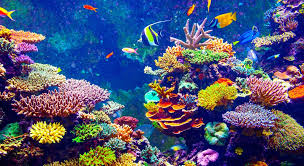(单词翻译:单击)
Leaders
来源于《商业》版块
Coral reefs
珊瑚礁
No longer in the pink
不再健康
The world is going to have to start thinking radically to save its coral reefs
世界将不得不开始从根本上思考如何拯救珊瑚礁
Corals are comeback creatures. As the world froze and melted and sea levels rose and fell over 30,000 years, Australia’s Great Barrier Reef, which is roughly the size of Italy, died and revived five times. But now, thanks to human activity, corals face the most complex concoction of conditions they have yet had to deal with. Even these hardy invertebrates may struggle to come through their latest challenge without a bit of help.
珊瑚是回归的生物。随着世界冰冻、融化,海平面在3万多年间起起落落,澳大利亚的大堡礁,这个和意大利差不多大的地方,经历了五次死亡和复活。但现在,由于人类的活动,珊瑚面临着迄今为止最复杂的混合环境。即使是这些顽强的无脊椎动物,在没有一点帮助的情况下,可能也很难度过最近的挑战。
According to the Intergovernmental Panel on Climate Change, a rise in global temperatures of 1.5°C relative to pre-industrial times could cause coral reefs to decline by 70-90%. The planet is about 1°C hotter than in the 19th century and its seas are becoming warmer, stormier and more acidic. This is already affecting relations between corals and the single-celled algae with which they live symbiotically, and which give them their colour. When waters become unusually warm, corals eject the algae, leaving reefs a ghostly white. This “bleaching” is happening five times as often as it did in the 1970s. The most recent such event, between 2014 and 2017, affected about three-quarters of the world’s reefs. Meanwhile the changing chemistry of the oceans lowers the abundance of carbonate ions, making it harder for corals to form their skeletons.
根据政府间气候变化专门委员会的数据,全球气温与工业化前相比上升1.5摄氏度,可能会导致珊瑚礁面积减少70-90%。地球的温度比19世纪高了1摄氏度,海洋也变得越来越温暖,风暴也越来越多,酸性也越来越强。这已经影响到珊瑚与它们共生的单细胞藻类之间的关系,而单细胞藻类赋予了珊瑚颜色。当海水变得异常温暖时,珊瑚会排出藻类,使珊瑚礁呈现出幽灵般的白色。这种“漂白”现象发生的频率是上世纪70年代的5倍。最近一次这样的事件发生在2014年至2017年之间,影响了全球约四分之三的珊瑚礁。同时,海洋化学物质的变化降低了碳酸盐离子的丰度,使得珊瑚更难形成骨骼。

If corals go, divers and marine biologists are not the only people who will miss them. Reefs take up a fraction of a percent of the sea floor, but support a quarter of the planet’s fish biodiversity. The fish that reefs shelter are especially valuable to their poorest human neighbours, many of whom depend on them as a source of protein. Roughly an eighth of the world’s population lives within 100km of a reef. Corals also protect 150,000km of shoreline in more than 100 countries and territories from the ocean’s buffeting, as well as generating billions of dollars in tourism revenue. In the Coral Triangle, an area of water stretching across South-East Asia and into the Pacific which is home to three-quarters of known coral species, more than 130m people rely on reefs for food and for their livelihoods in fishing and tourism.
如果珊瑚消失了,潜水者和海洋生物学家不是唯一会想念它们的人。珊瑚礁只占海床的百分之一,却支撑着地球上四分之一的鱼类生物多样性。珊瑚礁中栖息的鱼类对它们最贫穷的人类邻居来说尤其有价值,他们中的许多人依赖它们作为蛋白质的来源。世界上大约有八分之一的人口生活在距珊瑚礁100公里以内的地方。珊瑚还保护着100多个国家和地区15万公里的海岸线免受海洋冲击,并为旅游业带来数十亿美元的收入。珊瑚三角区是一片水域,横跨东南亚,一直延伸到太平洋,是四分之三已知珊瑚物种的家园。在这里,超过1.3亿人依靠珊瑚礁获取食物,靠捕鱼和旅游业维持生计。
译文由可可原创,仅供学习交流使用,未经许可请勿转载。


